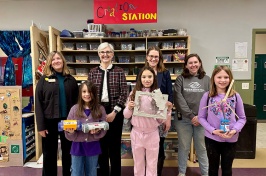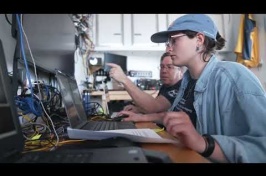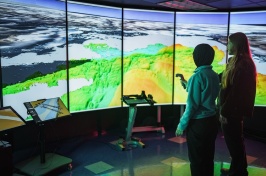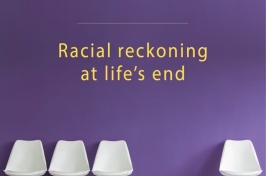The University of New Hampshire inspires innovation and transforms lives in our state, nation and world. More than 16,000 students from all 50 states and 71 countries engage with an award-winning faculty in top-ranked programs in business, engineering, law, health and human services, liberal arts and the sciences across more than 200 programs of study. A Carnegie Classification R1 institution, UNH partners with NASA, NOAA, NSF and NIH, and received $260 million in competitive external funding in FY21 to further explore and define the frontiers of land, sea and space.
USDA Ag Census Finds N.H. Farmers Moving to More Sustainable Agriculture Practices
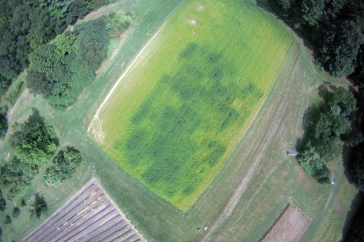
An aerial photo shows a checkerboard pattern of the cover crop project at the experiment station’s Woodman Horticultural Research Farm. Areas that had previously been planted with forage radish or some of the legume were much darker green than areas where other cover crops had been planted. Credit: Rich Smith/UNH
DURHAM, N.H.—New Hampshire farmers are increasingly moving to more sustainable farming practices, with those adopting no-till, reduced-till, and cover crop practices dramatically increasing since 2012, according to the 2017 Census of Agriculture. The University of New Hampshire has conducted extensive research on these sustainable agriculture practices and worked to educate Northeast farmers about them.
Self-reported data from the 2017 Census of Agriculture, released in April of this year, shows the number of acres of cropland under no-till practices increased by 147 percent from 2012 to 2017, from 1,908 acres to 4,714. Farmers report the number of acres under reduced-till practices also increased, from 4,145 acres to 5,535. The number of acres of Granite State cropland under no-till or reduced-till practices (10,249 acres) now exceeds cropland under intensive tilling (8,868 acres). The number of acres under intensive tilling dropped from 13,429 to 8,868, or 34 percent.
In addition, the number of acres of cropland planted with cover crops increased from 5,025 acres to 8,326, an increase of 66 percent. Cover crops are plants that are grown before or after cash crops are planted and harvested. They protect soil from erosion, improve soil fertility, suppress weeds, and/or provide additional habitat for pollinators and other beneficial organisms. Because they minimize erosion and can help to keep nitrogen and other nutrients from leaching to ground waters or being lost via other pathways, cover crops can be important tools for reducing pollution and other negative environmental impacts associated with agricultural activities.
“These data are good news for not only farmers, but for the citizens of New Hampshire,” said New Hampshire Agricultural Experiment Station researcher Richard Smith, associate professor of agroecology, who has conducted extensive research about these sustainable farming practices. “Farmers are benefiting from the biological sources of fertility, weed suppression, and soil protection that cover crops provide to their farming systems, and the public benefits from all of the other ancillary effects that come from wider spread use of cover crops, including cleaner water and a more resilient food supply.”
Previous research by Smith and his colleagues found that forage radish could be a beneficial cover crop for New Hampshire farmers wanting to suppress weeds in the fall and improve soil fertility for spring-sown crops. “It was consistently among the highest biomass-producing species in the fall, provided excellent fall weed suppression and resulted in some of the highest productivity values in the test-crop.”
The researchers also found that cover crops can help reduce the need for tillage in some organic vegetable systems. Specifically, they investigated using black tarps to kill cover crops prior to planting a cash crop. Once the tarps are removed, the cash crop can be planted directly into the dead cover crop, providing a weed-suppressive mulch for most of the growing season. This allows farmers to forgo tilling.
“Many people relish the bucolic image of a plowed field or a tilled garden, but tilling the soil has deleterious effects on soil structure and biology,” said Natalie Lounsbury, a doctoral student in agroecology and member of Smith’s research lab. “A tilled, bare soil is vulnerable; in a dry summer it dries out quickly, leaving plants struggling to get enough water, and in a wet year, it is susceptible to erosion losses. Nonetheless, tillage is the standard practice for vegetable production, largely because of the need to control weeds.”
This material is based upon work supported by the NH Agricultural Experiment Station, through joint funding of the National Institute of Food and Agriculture, U.S. Department of Agriculture, under award number 229253, and the state of New Hampshire.
Founded in 1887, the NH Agricultural Experiment Station at the UNH College of Life Sciences and Agriculture is UNH’s original research center and an elemental component of New Hampshire's land-grant university heritage and mission.
Editors and reporters: Richard Smith is available to discuss sustainable agriculture practices in New Hampshire. He can be reached at richard.smith@unh.edu.
PHOTOS AVAILABLE FOR DOWNLOAD
https://colsa.unh.edu/nhaes/sites/colsa.unh.edu.nhaes/files/media/images/unhcovercrops.jpg
An aerial photo shows a checkerboard pattern of the cover crop project at the experiment station’s Woodman Horticultural Research Farm. Areas that had previously been planted with forage radish or some of the legume were much darker green than areas where other cover crops had been planted. Credit: Rich Smith/UNH
https://colsa.unh.edu/nhaes/sites/colsa.unh.edu.nhaes/files/media/images/cabbage_black_tarp.jpg
Areas where weeds were suppressed using black tarps had nearly no weeds six weeks after transplanting cabbage. Credit: Rich Smith/UNH
https://colsa.unh.edu/nhaes/sites/colsa.unh.edu.nhaes/files/media/images/tarpremoval.jpg
Scientists saw a clear grid pattern at the research site where black tarps, white tarps, and no tarps had been located. Credit: Rich Smith/UNH
-
Media Contact
Lori Tyler Gula, PhD | NH Agricultural Experiment Station | lori.gula@unh.edu | 603-862-1452
Latest News
-
March 12, 2025
-
February 19, 2025
-
February 6, 2025
-
February 5, 2025
-
January 15, 2025





























